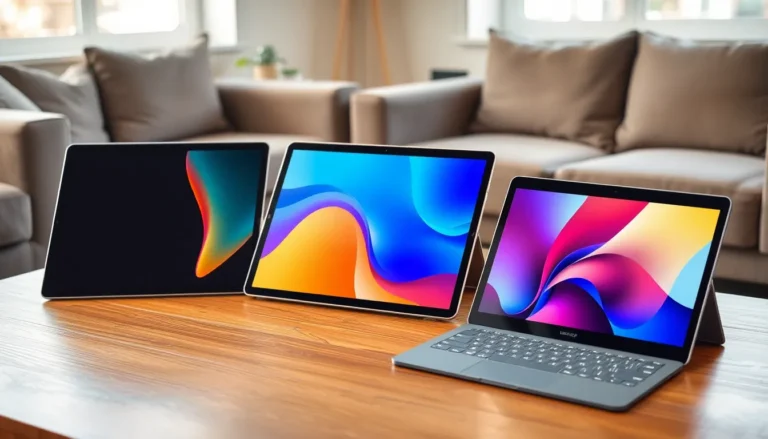In a world where bigger often seems better, choosing the right tablet size can feel like navigating a maze blindfolded. With options that range from pocket-sized wonders to tablet titans, it’s easy to get lost in the sea of screens. But fear not! Finding the perfect fit isn’t just about size; it’s about matching your lifestyle with a device that’s as handy as a Swiss Army knife.
Imagine this: you’re on a crowded subway, juggling your morning coffee and a tablet that could double as a dinner tray. Not ideal, right? Whether you’re binge-watching your favorite series or conquering a spreadsheet, the right tablet size can make all the difference. So let’s dive into the delightful world of tablet dimensions, where practicality meets portability, and discover which size will elevate your tech game to new heights.
Table of Contents
ToggleUnderstanding Tablet Size
Tablet size plays a crucial role in the user experience. Larger models typically range from 10 to 12 inches, making them suitable for tasks like watching videos and multitasking with multiple apps. Smaller tablets, on the other hand, often fall between 7 and 9 inches, appealing to users who prioritize portability and ease of handling.
Choosing the right size depends on specific needs. For instance, artists may prefer larger screens for drawing, while readers might opt for compact devices for comfortable book reading. Additionally, travel habits influence preferences, as lightweight options fit easily into bags.
Screen resolution varies with size. Smaller tablets might feature lower resolutions, while larger devices often present HD displays. Users who often watch movies or play games benefit from greater clarity and detail. Weight also differs significantly; larger tablets can be heavier, impacting usability during lengthy sessions.
Considering ergonomics is vital. Gripping larger tablets for extended periods can lead to discomfort. Therefore, selecting a size that allows relaxed use is essential. Users often notice the differences in hand feel and maneuverability when switching between sizes.
Ultimately, assessing lifestyle factors guides tablet size decisions. A student might require versatile functionality for note-taking, while a casual user benefits from straightforward browsing experiences. Understanding personal requirements and usage patterns enables individuals to select a tablet that seamlessly integrates into daily routines.
Importance of Tablet Size


Choosing the right tablet size directly affects user experience and portability. Selecting a tablet involves evaluating how the size aligns with individual preferences and daily use.
User Experience
User experience varies widely with tablet size. Larger tablets, ranging from 10 to 12 inches, provide spacious screens ideal for tasks such as watching videos, multitasking, and creative work. Smaller tablets, sized 7 to 9 inches, offer a more compact design for reading and casual browsing. The choice impacts screen resolution, which can influence visual clarity, especially during extended use. Ergonomics matter too; larger devices can strain arms and hands if held for too long, while smaller ones promote ease of handling. Specific tasks dictate needs, making it crucial to consider how the tablet will be used most frequently.
Portability
Portability plays a pivotal role in tablet size selection. Smaller tablets are easy to carry, fitting comfortably in bags or even pockets. This convenience appeals to travelers and commuters who require devices for on-the-go access. Larger tablets, while not as portable, offer functionality that supports productivity, making them suitable for home office setups or casual use at cafes. Understanding personal habits shapes choices; a user who frequently travels might favor a lightweight option, whereas someone prioritizing a larger display at home may lean toward bigger models. Balancing portability with functionality helps in making a well-informed decision.
Popular Tablet Sizes
Tablet sizes vary widely, allowing users to choose options that best fit their lifestyles and needs. Exploring the different categories helps in understanding what each size offers.
Small Tablets
Small tablets typically range from 7 to 9 inches, making them lightweight and easy to hold. These devices excel in portability, appealing to readers and casual browsers. Users enjoy the convenience of slipping them into bags for travel or commuting. Activities like reading eBooks or browsing the internet suit these devices well. Battery efficiency also tends to be high, allowing for prolonged usage without constant recharging.
Medium Tablets
Medium tablets usually span from 9 to 10 inches, balancing portability and functionality. This size caters to those who multitask, like managing emails while watching videos. They often serve as excellent devices for students taking notes during lectures. The improved screen size enhances productivity while remaining comfortable for extended use. Users appreciate their versatility in both entertainment and task-oriented activities.
Large Tablets
Large tablets, measuring 10 to 12 inches, provide expansive screens for immersive experiences. Creative professionals benefit from the added space for design work or detailed editing. These devices support applications requiring higher performance, making them popular among gamers and multimedia enthusiasts. However, their increased size can affect portability, requiring more effort to carry. Ergonomics play a significant role, as using these tablets for long periods without proper support may lead to discomfort.
Choosing the Right Tablet Size
Selecting a tablet size involves understanding various factors beyond mere dimensions. Personal usage scenarios often dictate the most suitable choice.
Considerations for Different Use Cases
Different use cases determine the optimal tablet size. Large tablets, ranging from 10 to 12 inches, work well for creative tasks, multitasking, and watching videos. They excel in delivering immersive visual experiences. Smaller tablets, typically between 7 to 9 inches, cater to readers and casual browsers seeking portability. Their light weight makes them handy for on-the-go use. Medium-sized tablets, between 9 to 10 inches, strike a balance, fitting those who need both functionality and convenience. Users should evaluate their primary activities, whether that includes gaming, drawing, or reading, to make an informed decision.
Personal Preferences
Personal preferences also play a critical role in tablet size selection. Some individuals prioritize a lightweight design, favoring smaller models for easy handling. Others enjoy the expansive display of larger tablets for a rich multimedia experience. Comfort during extended use significantly impacts choice; those requiring ergonomic benefits often lean towards medium models that balance size and usability. Specific activities, such as sketching or note-taking, may influence individuals to select tablets with features like stylus support or enhanced display quality. Ultimately, knowing one’s personal inclinations aids in identifying the right tablet size.









